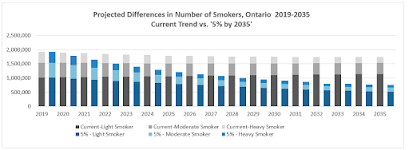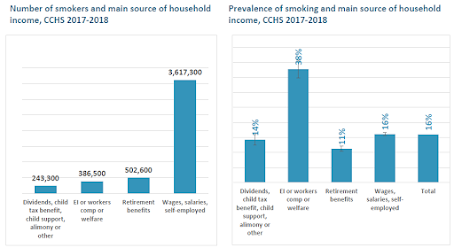This week the CBC reported that earlier this month the Nova Scotia government has been served with a notice from local vaping merchants that they are asking that province's courts to strike down certain vaping regulations. The argument they will present to the court is that sections of the Tobacco Access Act violate the human rights of vapers.
This lawsuit was no surprise. Since late winter, GOFUNDME campaigns had been underway to raise money for this endeavour. The first campaign raised $38,000, and the second raised $107,000.
Nor is this the first constitutional challenge to provincial restrictions on vaping products.
In the spring of 2016, the Quebec government faced similar challenges from the Quebec Vaping Association (L'association Québécoise des vapoteries) and the Canadian Vaping Association. Those groups claimed that sections of the Quebec Tobacco Control Act, which had been adopted in November 2015, were in conflict with rights protected under the Quebec and Canadian Charters of Rights.
And it may not be the last! British Columbia's strict regulations, some of which come into force this week, have also been accused of being contrary to Canada's Charter.
This post presents a brief overview of these legal claims, and of the court decisions to date.
NOVA SCOTIA
The regulations
In 2020, Nova Scotia put in place three major changes to its vaping controls:
 |
Cloud Factory
Dartmouth Location
|
The legal challengeNotice of the legal challenge to these measures was filed on September 8, 2020 by Halifax lawyer Michael Scott of Patterson Law on behalf of the Cloud Factory Vape Shop and its part-owner Edward MacEachern. This store does not appear to be a large commercial undertaking, with a small number of outlets located in strip malls in Dartmouth and Fall River, Nova Scotia.
This document advises the government that the court will be asked to:
- strike down those sections of the Tobacco Access Act which ban the sale of flavoured e-cigaretets (s. 3(e), 3(ba) and 7)
- strike down those sections of the Smoke-Free Places Act which ban using vaping products in retail stores (s. 5(a)(j)).
- strike down those sections of the Revenue Act which impose a tax on vaping liquids (s. 46C-E)
The vape store owner claims that these restrictions run against his right, outlined in section. 7 of Canada's Charter of Rights and Freedoms, to "life, liberty and security of the person." (The application did not claim that limits on nicotine concentration were unconstitutional.)
Although the details are sketchy (there are only 14 substantive paragraphs in the legal document), some of the arguments that will be made in support of this claim are outlined. These include the claim that bans on flavours "unreasonably deprive adults of an important part of their smoking cessation method (flavoured vaping liquid)," that the ban on trying vaping products in stores does not protect youth but arbitrarily infringes the rights of adult vapers, and that the tax on vaping products infringes on rights "held by those who legitimately rely on vaping as part of their smoking cessation strategy."
This will be a two-step legal process. In the first hearing (identified in the documents as being on November 30th), they will be asking for an immediate injunction striking down those sections of the law until their case can be fully heard. For the main trial, which they they could be ready for within a year, they have identified 4 categories of expert witness, and estimate that a 5-day hearing will be required.
QUEBEC
The regulations
Quebec substantially amended its
Tobacco Control Act in November 2015 to bring electronic cigarettes and vaping products under many of the same restrictions that were applied to combustible and other tobacco products. As exceptions to the rules for tobacco, these revisions allowed e-cigarettes to be displayed in specialty stores (but not sampled), and allowed e-cigarettes to be sold in flavours.
The legal challenge
In March and April 2016, both the Association Québécoise des vapoteries and the Canadian Vaping Association filed separate legal challenges to some of these new measures. These two cases were combined, and an 11-day hearing took place in December 2018.
The main issues considered by the court were:
- Does Quebec have a right to legislate in this area when the federal government has adopted different measures?
- Do restrictions on advertising vaping products infringe the right to security of the person and right to expression provided for in the Canadian and Quebec Charter of Rights and Freedoms?
- Do prohibitions on trying vaping products in specialty stores infringe the right to security of the person provided for in the Canadian and Quebec Charters?
In May 2019, Justice Dumais of the Quebec Superior Court issued a ruling (
2019qccs1644) in which he decided that:
- The federal Tobacco and Vaping Products Act does not preclude Quebec from passing its own restrictions in vaping marketing, and the two laws are not incompatible with each other.
- Most aspects of the Quebec law do not infringe Charter rights to the security of the person.
- The restriction on allowing people to try the product in stores did limit the rights of vapers to security of the person and there was no justification for this infringement. (Justice Dumais struck down s. 2(1) and 2(12) of the Tobacco Control Act)
- Those provisions of the Quebec law which prohibited advertising vaping products to smokers as a cessation device were also an infringement of expression rights under the Charters, and the infringement was not justified. (He struck down s. 24(4, 8, 9 and paragraph 3 of the Tobacco Control Act and s 6.4(2) of regulations under that act).
The Quebec government
filed an appeal of that ruling in June, 2019, claiming that the judge had made 'palpable and overriding errors'. Among these errors were the judge's view that vaping products were sold as cessation products for smokers only and that they were not also consumer goods targeting the broader population. The appeal also considers that the judge erred in the way he minimized the health risks associated with vaping.
A hearing date for this appeal has apparently not yet been scheduled. The Canadian Cancer Society has been
granted intervenor status in the appeal.
The Quebec government has not modified its law in response to the ruling, nor has it materially strengthened its restrictions on vaping marketing as other provinces have done.
Last November, it commissioned a group of experts to provide advice on measures to address vaping, but their report (which was due in April) has not yet been made public. The 5-year review of the Quebec law is due to be submitted to the legislature in November 2020.
Will there be more?
These measures may be the subject of additional lawsuits --- or there may be some already filed that have not been made public. Governments are under no obligation to disclose whether their health regulations are being challenged.
Notably absent from the Nova Scotia and Quebec challenges are the multinational tobacco companies, which have historically spearheaded constitutional challenges to health regulations, and which generally sell through convenience stores, not specialty vape shops.








